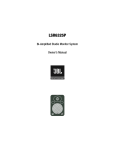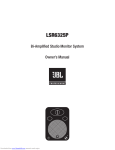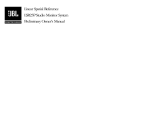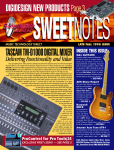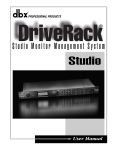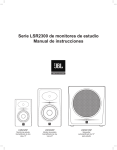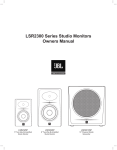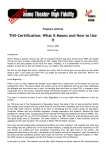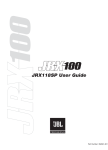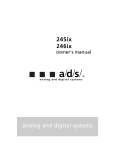Download JBL LSR6300 User's Manual
Transcript
LSR6300 Studio Monitors Owner’s Manual Important Safety Instructions 1. Read These Instructions - Before operating your new JBL product, please read safety and operating instructions. Explanation of Graphic Symbols 2. Keep These Instructions - For future reference and troubleshooting purposes, retain these instructions. The exclamation point within an equilateral triangle is intended to alert the users to the presence of important operating and maintenance (servicing) instructions in the literature accompanying the product. 3. Heed All Warnings - All warnings in this manual should be followed. 4. Follow All Instructions 5. Water and Moisture - This product is intended for indoor use only. Do not use this apparatus near water or plumbing fixtures. The lightning flash with the arrowhead symbol, within an equilateral triangle, is to alert the user to the presence of insulated “dangerous voltage” within the products enclosure that may be of sufficient magnitude to constitute a risk of electric shock to humans. 6. Cleaning - Do not use any solvent based cleaners on the finish. To clean enclosure, turn off speaker and disconnect power cord then clean only with a lint-free cloth moistened with water. 7. Ventilation - Do not block any ventilation openings, including the Linear Dynamics Aperture Port on the monitor systems. Install these products in accordance with manufacturers instructions. Do not install near any heat sources such as radiators, heat registers, stoves or other apparatus that produce heat. 8. Grounding and Power Cords - Protect the power cord from being walked-on or pinched, particularly at the plug’s convenience recepticle and the point where it connects to the apparatus. Do not defeat the safety purpose of the grounding type plug. The power cord supplied with your powered product has a plug with 2 blades plus a 3rd grounding prong. Do not cut off or damage the grounding prong. If the provided plug does not fit into your outlet, consult an electrician for replacement of the obsolete outlet. All powered products are fitted with a detachable power cord (supplied) which connects to the chassis AC connector. The power cord has an IEC female connector on one end and a male mains connector on the other end. This cord is supplied specifically to accommodate the different safety and electrical code requirements of individual countries. If you are traveling abroad with your system, test the power mains and be aware of any specific voltage requirements before operating your system. CAUTION RISK OF ELECTRIC SHOCK DO NOT OPEN! DO NOT EXPOSE TO RAIN OR MOISTURE! ATTENTION RISQUE DE CHOC ÉLECTRIQUE NE PAS ENLEVER! NE PAS EXPOSER Á LA PLUIE NI Á L'HUMIDITÉ! CAUTION: TO REDUCE THE RISK OF ELECTRONIC SHOCK - DO NOT REMOVE COVER. NO USER SERVICEABLE PARTS INSIDE. REFER SERVICING TO QUALIFIED PERSONNEL. DO NOT EXPOSE THIS APPARATUS TO RAIN OR MOISTURE. ATTENTION: POUR EVITER LES RISQUES DE CHOC ELECTRIQUE, NE PAS ENLEVER LE COUVERCLE. AUCUN ENTRETIEN DE PIECES INTERIEURES PAR L’USAGER. CONFIER L’ENTRETIEN AU PERSONNEL QUALIFIE. AVIS: POUR EVITER LES RISQUES D’INCENDIE OU D’ELECTROCUTION, N’EXPOSEZ PAS CET ARTICLE A LA PLUIE OU A L’HUMIDITE. 9. Options - Only use attachments or accessories specified by JBL Professional. 10. Wall or Ceiling Mounting - The appliance should be mounted on a wall or ceiling only as recommended by the manufacturer. Caution: Unsafe mounting or overhead suspension of any heavy load can result in serious injury and equipment damage. Mounting of speakers should be done by qualified persons in accordance with all applicable local safety and construction standards. Be certain to follow the instructions provided by the manufacturer of the mounting bracket. Before selecting a mounting bracket, be certain that it is capable of supporting the weight of the speaker to be mounted. 11. Non-use Periods - Unplug this apparatus during lightning storms or when it will be unused for long periods of time. 12. Servicing - Refer all servicing to qualified service personnel. Servicing is required when the apparatus does not operate normally or has been damaged in any way, including: power supply cord or plug is damaged, water or other liquid has been spilled or objects have fallen into the apparatus. 13. Carts and Stands - The appliance should be used only with carts or stands that are sturdy and well balanced. All appliance and cart combinations should be moved with care. Quick stops, excessive force, and uneven surfaces may cause the appliance and cart combination to overturn. 14. Fire - No naked flame sources, such as lighted candles, should be placed on the surface, of the apparatus. 15. Coupler - The appliance coupler is used as the disconnect device, and the appliance coupler shall remain readily operable. 2 The information contained in this document is confidential and the copyright of JBL Professional. To convey its contents, in part of it whole, to any party without prior written authorization is a violation of the copyright. © JBL Professional 2003 Table Of Contents Introduction 4 Getting Started Unpacking Placement Power Connections Making Sound 5 LSR6328P Biamplified Studio Monitor System Audio Connections AC Power Connections Audio Level Adjustment Low Frequency Adjustment High Frequency Adjustment LED Indication RMC Equalization 5 5 6 6 7-9 7 8 8 8 9 9 9 LSR6332 Studio Monitor System Audio Connections High Frequency Adjustment Changing Mid/High Orientation 10 - 11 LSR6312SP Powered Studio Subwoofer System Audio Connections AC Power Connections Audio Level Adjustment Low Frequency Adjustment LED Indication RMC Equalization System Configuration 12 - 15 Appendix A. Wiring Requirements B. Mounting Specifications C. RMC™ Room Mode Correction System Specifications 16 - 18 Specifications LSR6328P LSR6332 LSR6312SP 19 - 21 10 10 11 12 13-14 14 14 14 14 15 16 - 17 18 18 19 20 21 Warranty Statement 23 JBL Professional Contact Information 24 3 Introduction Congratulation on your purchase of LSR6300 Studio Monitors. All LSR6300 models incorporate proprietary and patented JBL transducer and network technologies., to provide ultra-accurate response, and exceptional SPL capability. Because production rooms are acoustically less-than-perfect, JBL has incoporated technologies in the LSR6300 Studio Monitors to overcome problems in the room. The result: clear accurate sound at the listening position in any room. LSR6300 Features to Overcome the Problems in the Room LSR - Linear Spatial Reference Technology JBL developed Linear Spatial Reference Technology to improve mid and high frequency accuracy at the listening position where reflected sound comes into play. By meeting frequency response criteria for seventy-two off-axis measurements, the LSR6300 Studio Monitors ensure that not just the direct sound, but the reflected sound that reaches you at the listening position is also smooth and accurate. RMC™ - Room Mode Correction The LSR6328P and LSR6312SP Subwoofer are equipped with RMC - JBL’s method of zeroing out bass problems at the listening position caused by room modes. The LSR6332 Studio Monitor and other speakers enjoy the benefits of RMC when used in a system with the LSR6312SP Subwoofer. The RMC Calibration Kit* gives you everything you need to tune your LSR system and compensate for the room modes in the listening environment. *Included with the LSR6312SP, Optional accessory for the LSR6328P Boundary Compensation LSR6328P and LSR6312SP boundary compensation presets restore accurate bass response when the loudspeakers are wall mounted or positioned close to walls, corners and placed on work surfaces. Mounting Options LSR6300 enclosures are reinforced to make them safe for mounting and mounting points are provided for use with readily available, industry-standard mounting brackets. THX® pm3™ All LSR6300 models are THX® pm3™ approved for use in the most demanding production applications and environments. JBL Transducer Technologies Differential Drive® New voice coils and motor assemblies have two separate drive coils with twice the thermal surface area of traditional speakers. This enables LSR6300 systems to provide higher peak output with less power compression, greater heat dissipation and a flatter impedance curve at higher frequencies. By reducing the thermal related effects, the LSR6300 Studio Monitors sound the same at low, medium or high levels. Linear Dynamics Aperture™ Contoured ports virtually eliminate high-end turbulence found in traditional port designs. This provides more accurate low frequency performance at higher output levels. Dynamic Braking All LSR6300 low frequency transducers are equipped with an electromagnetic braking voice coil to reduce the effects of extreme excursion with high transient program materials. Titanium Composite High-Frequency Device Using patented technology, the high frequency device incorporates titanium and composite materials to improve transient response and reduce distortion. By reducing distortion in the lower operating range, where the ear is most sensitive, ear fatigue is radically reduced. Elliptical Oblate Spheroidal (EOS) Waveguide Designed for a targeted listening window of ±30º horizontally and ±15º vertically, the EOS waveguide provides a frequency response through the entire window of 1.5 dB from on-axis response. This allows listeners at a distance from the speakers and even far off-axis to hear an accurate representation of the on-axis response. Neodymium Midrange with Kevlar™ Cone A 2” neodymium motor structure is used in the LSR6332 for high excursion capability with an intentionally low crossover point of 250 Hz. This improves the spatial response of the system, which is crucial for accurate reproduction. 4 Getting Started Unpacking: When removing the systems from their packaging, it is important not to grasp the units from the front. Because the high frequency device is located near the top of the cabinet on the front baffle, a stray hand or finger can cause damage. The best way to safely unpack your monitors is to open the top of the box, keep the cardboard filler piece on, and roll the box upside down. The box can then be slipped off. This also works in reverse for repacking the units. Placement: The design of the LSR6300 systems lend themselves to a wide variety of placement options. Covered here is a typical stereo setup for near to mid field monitoring. A more detailed discussion of multi-channel sound system placement is available from JBL in Tech Note Volume 3, Number 3. Listening Distance: The common listening position at mixing postions is generally 1 to 1.5 meters (3 to 5 feet) for near field applications. For mid-field applications, 2 to 3 meters is more likely. The stereo listening angle is largely a matter of personal preference, and we suggest the angle of the loudspeakers should be between 35 and 50 degrees, as shown in Figure A. Figure A 35-50˚ 35-50˚ 35-50˚ Vertical vs. Horizontal Placement: The LSR6328P model is designed to be positioned vertically. This orientation eliminates the phase shifts that occur when the relative distances between the woofer, tweeter and the listening position are altered. The high frequency waveguide is designed to provide optimum dispersion when the system is placed vertically. Placing the system horizontally will defeat the LSR principles and cause destructive reflection off the work surface. The LSR6332 is normally used in the horizontal position. This provides the lowest elevation to maximize sight lines and reduce shadowing of soffit mount monitors. In applications where vertical orientation is desired, the entire mid and high assembly can be rotated 90° to a vertical line array position, as shown below in Figure B: Figure B 5 Getting Started The LSR6312SP can be placed in either a vertical or horizontal orientation. More important than orientation is the physical position in the room. Angling toward the listening position: The LSR6300-Series monitors should be angled to directly face the listener. The center of the high frequency transducer should be on-axis with the ear level of the listener. Ideally, full-range speakers should be placed on suitable speaker stands away from boundaries. The LSR6312SP Subwoofer can be located on the floor with its woofer cone on the same plane as the woofer cones of the full-range speakers. Alternately, the Subwoofer performance can benefit from placement close to a wall or corner. LSR6328P and LSR6312SP models include Boundary Compensation settings when speakers are placed in close proximity to walls, corners and work surfaces. Audio Connections Refer to individual model-specific instructions. Power Connections The LSR6328P can be used with multiple AC supply voltages around the world. It will automatically adjust for operation from 100 to 240 VAC with no intervention by the user. The ground terminal of the IEC plug is required by wiring codes and regulations. It must always be connected to the electrical installation safety ground. The LSR6300-Series units have carefully designed internal grounding and balanced inputs and outputs to reduce the possibility of ground loops (hum). If hum occurs, see Appendix B for suggested audio signal wiring, system grounding hints and other preventive measures. The LSR6312SP is set at the factory for use with either 100V125V or 200V-250V. Voltage is not field selectable. Making Sound After connections are made, the next step is to power up all equipment before powering up active LSR6300 speakers and external amplifiers. Reduce the level of the monitor outputs of your console or preamp to minimum and turn on the powered speakers and the amplifiers. There is a small delay with the power-up of the LSR6328P and LSR6312SP to accommodate for clicks and thumps from upstream equipment. When the Green LED on the front panel turns on, the units are ready to go. Slowly advance the gain of the console to feed the monitoring system to suitable listening level, and enjoy. Figure C 6 LSR6328P Biamplified Studio Monitor System The LSR6328P Bi-amplified Studio Monitor sets the standard for exceptional performance in near field design. With a combination of advanced transducer engineering and powerful drive electronics, the LSR6328P meets the professional’s requirement for accuracy and high dynamic range on the most demanding sessions. The addition of JBL RMC™ Room Mode Correction circuit and boundary compesnation ensures accurate low frequency response at the listening position, free of the spectral shift caused by room modes and the effect of boundaries. The 8" woofer is based on JBL's patented Differential Drive® technology. With dual 1.5" drive coils, power compression is kept to a minimum to reduce spectral shift as power levels increase. An added third coil between the drive coils acts as a dynamic brake to limit excess excursion and reduces audible distortion at maximum levels. The cone is made of a carbon fiber composite forming a rigid piston and is supported by a soft butyl rubber surround. The high frequency device is a 1" composite diaphragm integrated with an Elliptical Oblate Spheroidal (EOS) Waveguide with 100° by 60° dispersion, which is critical to the smooth spatial response required in today's working environments. The magnetically sheilding of the HF transducer reduces interference when used in close proximity to CRT video and computer monitors. This custom power supply eliminates all tonal-artifacts produced by the speaker when idling. Audio Connections LSR6328P Audio Connections: The LSR6328P comes with a Neutrik "Combi" connector that accommodates either an XLR or 1/4" connector in either balanced or unbalanced configurations. The system has switchable input sensitivity: +4 dBu, +8 dBu, and -10 dBV. These sensitivities are determined by adjusting the DIP switches according to the legend shown in Figure C. When the sensitivity is set for, say, +4 dBu, an input signal equal to +4 dBu will produce a system output level of 96 dB SPL at a distance of one meter. Likewise, settings of +8 dBu and -10 dBV will cause those input levels to attain the output acoustic level of 96 dB SPL. An additional switch allows user-adjustable input sensitivity via a screwdriver control on the back panel. See Section 4 for additional information on level control and gain matching. Positive voltage to Pin 2 of the XLR or the tip of the 1/4" jack will produce a forward motion in the low frequency cone. Shown below in Figures C and D are views of the rear electronics panel on the LSR6328P and a signal flow diagram for the system. We recommend that you study these drawings in detail. Figure D 7 LSR6328P Biamplified Studio Monitor System AC Power Connections The LSR6328P can accommodate power from 100 to 250 VAC 50/60 Hz by way of an autosensing power supply. This requires no attention on the part of the user. The ground terminal of the IEC plug is required by wiring codes and regulations. It must always be connected to the electrical installation safety ground. The LSR6300 Series models have carefully designed internal grounding and balanced inputs and outputs to reduce the possibility of ground loops (hum). If hum or buzz occur, see Appendix A for suggested correct audio signal wiring and system grounding. Audio Level Adjustment The audio level sensitivity of the LSR6328P can be adjusted for almost any situation. Monitor outputs of consoles and work stations are normally at a nominal level of +4 dBu or -10 dBV. The LSR6328P can be set up for fixed or variable gain. As shipped from the factory, a nominal signal input of -10 dBV (0.3 volts) will produce an output of 94 dB SPL at 1 meter in an anechoic environment. This allows the user to get a good match when using either professional or semiprofessional equipment. Using the DIP switches on the back as shown below in Figure E, the system can be set for +4 dBu, +8 dBu or +12 dBu sensitivity. Switch 1 enables the Trim Control. With the switch in the down position, the Trim Control is out of the circuit and does not affect the input sensitivity. In the up position, the input trim is added to the circuit and will attenuate the input level from 0 - 13 dB relative to nominal. • Switch 2 lowers the input sensitivity to +4 dBu sensitivity when in the up position. • Switch 3 lowers the input sensitivity to +8 dBu sensitivity when in the up position. • Switches 2 and 3 in the up position lower input sensitivity to +12 dBu. Figure E Low Frequency Adjustment The low frequency response of the LSR6328P can be adjusted to increase or reduce the low frequency output level. With all bass adjustment switches off, the unit is set to a 36 dB/octave roll-off with a maximally flat characteristic. Switch 4 - VLF, Very Low Frequency Protect: Switch 4 changes the low frequency roll-off to a 24 dB/octave slope, which extends the low frequency capability, while slightly reducing maximum sound pressure level. This is useful for spotting subsonic signals that could otherwise go undetected. For example, extreme low frequency rumble will be visible as a pronounced "fluttering" motion of the woofer cone. To protect the low frequency transducer, normally switch 4 is set to Off. 8 LSR6328P Biamplified Studio Monitor System Boundary Compensation Switch 5 introduces a low frequency shelf roll-off of -1.5 dB, while Switch 6 introduces a low frequency shelf rolloff of -3 dB. Engaging both switches will produce a low frequency shelf rolloff of -4.5 dB. These functions are known as Boundary Compensation and are used to adjust for the build-up of low frequencies that accompany the placement of loudspeakers near walls or corners, or work surfaces. The changes in low frequency response using Switches 4, 5, and 6 are shown in Figure F. 15.00 Amplitude (dBu) Diagram F 0 dB -1.5 dB -3.0 dB -4.5 dB 20.00 10.00 5.00 0.0 -5.00 -10.00 -15.00 -20.00 10 20 30 40 50 100 200 Frequency (Hz) High Frequency Adjustments Switch 7 introduces a high frequency response shelf cut of 1 dB above 2 kHz. This may be used if the room is fairly live, or if you are fairly close to the loudspeakers. Switch 8 introduces a high frequency response shelf boost of 1 dB above 2 kHz. This may be used if the room is extremely dead. The changes in high frequency response using Switches 7 and 8 are shown below in Figure G: 90 Switch 8 On +1 dB Switch 7 & 8 Off Flat Switch 7 On -1 dB SPL (dB) Figure G 80 70 60 10000 1000 Frequency (Hz) LED Indication A single LED indicator is located on the front of the LSR 6328P. In normal operation, this LED will be GREEN. At the onset of clipping in either the low or high frequency amplifier, the LED will flash RED. Continuous flashing of the red LED indicates that levels should be reduced. Caution: The LSR6328P is capable of producing extremely high sound pressure levels. To avoid hearing damage, caution should be exercised. RMC Equalization There are three screwdriver adjustable controls on the rear panel of the 6328P indicated RMC. The term RMC stands for Room Mode Correction, which consists of a single section cut-only parametric equalizer that can be adjusted in frequency, width (Q) of cut, and the amount of cut. It is used to reduce the magnitude of any dominant low frequency peak in response due to standing waves at the listening position. Details of Room Mode Correction are presented in the user guide included with the RMC Calibration Kit. 9 LSR6332 Studio Monitor System The LSR6332 Linear Spatial Reference Studio Monitor combines JBL's latest in transducer and technology with recent breakthroughs in system design to provide a more accurate studio reference in a variety of production environments. The neodymium 12" woofer is based on JBL's patented Neodymium Differential Drive NDD™ technology. With the Neodymium magnet structure and dual drive coils, power compression is kept to a minimum to reduce spectral shift as power levels increase. An added third coil between the drive coils acts as a dynamic brake to limit excess excursion and reduce audible distortion at the highest levels. The cone is made of a carbon fiber composite forming a rigid piston supported by a soft butyl rubber surround. The midrange is a 2" neodymium magnet structure with a woven 5" Kevlar cone. The powerful motor structure was chosen to support the low crossover point to the woofer. In order to achieve the goal of accurate spatial response, the crossover points are located at 250 Hz and 2.2 kHz. These transition points were chosen to match the directivity characteristics of the three transducers. The high frequency device is a 1" composite diaphragm integrated with an Elliptical Oblate Spheroidal (EOS) Waveguide with 100° by 60° dispersion, which is critical to the smooth spatial response required in today's working environments. The mid and high frequency drivers are mounted within millimeters of each other on a cast aluminum sub-baffle that can be rotated for horizontal or vertical placement. This allows maximum flexibility in placement to reduce console and ceiling splash that interferes with imaging and depth. The crossover filters are optimized to yield 4th-order (24 dB/octave) Linkwitz-Riley electroacoustic responses from each transducer (in phase; -6 dB at crossover). In order to achieve optimal symmetrical response in the vertical plane, both magnitude and phase compensation are implemented in the crossover network. The crossover network allows the user to adjust the high frequency level above 3 kHz. This allows the listener to compensate for effects of near-field or mid-field spectral balance or differing amounts of high frequency absorption. Components used in the crossover are exclusively low-loss metal film capacitors; low distortion electrolytic capacitors; highQ, high saturation current inductors and high current sand cast power resistors. The mid and high frequency transducers are magnetically shielded to reduce interference when used in close proximity to CRT video and computer monitors. Audio Connections The LSR6332 is equipped with two pairs of 5-way binding posts. The lower pair feeds the woofer and the top pair feeds the mid and high frequency elements. The connectors are designed to accept up to 10 AWG bare wire. Spacing of the two input terminal pairs allows use of standard Dual Banana jacks. The two pairs are normally connected together with metal shorting bars. This allows either pair to be used in normal operation. Alternative cabling possibilities include passive bi-amping, or using both terminals to get more "copper" from the amplifier to the speaker. Positive voltage to the "Red" (+) terminal will produce a forward motion at the low frequency cone. High Frequency Adjustments The LSR6332 High Frequency level can be adjusted to compensate for placement or for "bright" rooms. The unit is shipped in the "flat" or 0 dB position. If the system sounds too bright in your room, or if you are working very close to the monitors (under 1-1.5 meters). the response above 2 kHz can be reduced by approximately 1 dB, as shown in Figure H: Figure H 0 dB -1 dB 10 LSR6332 Studio Monitor System This adjustment is accomplished via the barrier strip on the back of the enclosure located above the dual pair of 5-way binding posts. Moving the link between the 0 and -1 dB positions will change the high frequency drive level. Please note that the loudspeaker should be disconnected from the amplifier during this procedure for safety of the system. Changing Mid/High Orientation The LSR6332 is normally used in the horizontal position with the mid- and high-frequency elements toward the middle. This provides the lowest elevation, maximizes sight lines and reduces shadowing effects of soffit mount monitors. In situations where vertical orientation is desired, the entire Mid/High sub-baffle can be rotated. There are both Left and Right models of the LSR6332 so that absolute symmetry can be maintained in all orientations. NOTE: The mid and high transducers can be easily damaged by screwdrivers carelessly handled. Even with efficient magnetic structures, there is always a small amount of leakage flux in the neighborhood of the voice coil gap, which will attract hand tools and any nearby iron material. Dented cones or domes are not covered under warranty. 1. Place the LSR6332 on its back on a stable work surface. 2. Carefully remove the eight Allen (Hex) socket screws surrounding the Mid/High sub-baffle, and pull the unit out entirely. 3. Gently lift the baffle out enough to rotate the assembly. You can use your hand in the port to assist. Do not pull the unit out entirely. This avoids unnecessary tension on the cabling assemblies. 4. Replace the eight screws and tighten. Again, take note to be VERY careful to guard against transducer damage. 11 LSR6312SP Powered Subwoofer System The LSR6312SP Active Subwoofer consists of a Neodymium Differential Drive NDD™ 12" neodymium woofer integrated with a powerful 260 watt continuous power output amplifier. The active drive circuitry has been developed to maximize the acoustic output power while maintaining overall low distortion and excellent transient performance. The enclosure is manufactured with a molded baffle and rigidly braced MDF enclosure for low resonance and minimal box loss. The Linear Dynamics Aperture (LDA) Port design minimizes port turbulence and eliminates port compression. Active crossover electronics supply 4th-order electroacoustic slopes to the low pass subwoofer transition to reduce the possibility of audible localization of the subwoofer. This allows greater flexibility in placement for optimum operation in a wide variety of rooms. Since low frequency energy supplied by the LSR6312SP is essentially omnidirectional, placement of the unit(s) is more dependent upon room acoustics and interaction than localization issues. The active electronics includes switchable high pass filters for the front satellite speakers. This option is used to filter low frequency information from the front speakers and redirect this information to the subwoofer. This is usually the case when the front speakers cannot reproduce extended low frequency information at the desired sound pressure level, or to optimize the low frequency performance of the system in the room. Alternatively, if the front channels are operated in full range, the bypass function can be enabled allowing the subwoofer to be muted. The bypass function allows the LSR6312SP direct LFE input to remain active. RMC Equalization There are three screwdriver adjustable controls on the rear panel of the LSR6328P indicated RMC. The term RMC stands for Room Mode Correction, which consists of a single section cut-only parametric equalizer that can be adjusted in frequency, width (Q) of cut, and the amount of cut. It is used to reduce the magnitude of any dominant low frequency peak in response due to standing waves at the listening position. Details of Room Mode Correction are presented in the user guide included with the RMC Claibration Kit. Audio Connections The LSR6312SP subwoofer contains both input and output XLR connectors for three channels, which are typically Left, Center and Right. An additional direct input is included which is active at all times. It This allows routing for a separate signal directly to the input electronics of the LSR6312SP, as well as the summed low frequency response of the Left, Center and Right inputs. The inputs are shipped with a sensitivity of -10 dBV, but this can be changed +0, +4 dBu, +8 dBu or +12 dBu by moving a dip switches on the back of the unit. A 12 dBu variable input trim can be switched in to calibrate input sensitivity to a precise setting. The outputs transmit either full range or high-passed program information, depending on the mode of the subwoofer. The summed output transmits a sum of the L, C, R and Direct input signals with no processing to allow chaining of multiple LSR6312SP subwoofers. Positive voltage to Pin 2 of the XLR will produce a forward motion in the low frequency cone. Shown below in Figures I and J are views of the rear electronics panel on the LSR6312SP and a signal flow diagram for the system. We recommend that you study these drawings in detail. Figure I With Differential Drive® Transducer Technology U.S. Patent Nos. 5,748,760 and 5,828,767 Other U.S. and Foreign Patents Pending Sensitivity +10 dB 0 dB Input Option Active Trim With Switch Up Cut Left In Left Out Center In Center Out LSR6312SP Linear Spatial Reference Powered Subwoofer 12 Right In Right Out Sub-Direct In Input Trim Active +4 dBu Input Sensitivity +8 dBu Input Sensitivity Signal Polarity Inverted -4 dB Bass Alignment RMC Defeat 0 dB LSR6312SP Powered Subwoofer System There are several ways to connect the LSR6312SP in a monitoring system including stereo, multi-channel formats such as Dolby ProLogic, AC-3, DTS, and others. The bass management system in the LSR6312SP provides the flexibility to switch between configurations. In a Stereo Configuration, it is typical to feed the LSR6312SP with the left and right channels and take the left and right outputs from the LSR6312SP and feed them to the satellites. The high pass filters on the subwoofer outputs remove the low frequency signal below 85 Hz from the satellites. This signal is then redirected to the subwoofer. Summed Out makeup gain The Dolby ProLogic format uses a similar connection scheme to the one above. The left, center and right channels route to the left, center and right inputs of the LSR6312SP and through the respective outputs to the satellites. Signals below 85 Hz are filtered out of the satellites and sent to the subwoofer. Other multichannel formats such as Dolby AC-3 and DTS may include six discrete channels, left, center, right, left surround, right surround and subwoofer. These are termed 5.1 for the five main channels and the dedicated "point-one" subwoofer channel, which is also called the low frequency effects, or LFE channel. Not all program material makes use of all channels, and mixing engineers have the discretion to use - or not use - the subwoofer channel. plug Figure J The Left, Center and Right channels are routed to the respective LSR6312SP inputs and on to the front channel LCR speakers. The LFE channel is sent directly to the Direct input of the LSR6312P. When not in bypass mode, the system operates as the stereo and Prologic setups previously described. All subwoofer information is derived from the front channels and the Direct subwoofer input. When a contact closure occurs, the high pass filtering is bypassed to the satellites and the satellites then receive the original full range signal. The sub-woofer feed from the Direct LFE input remains active. ! WARNING AVIS! SHOCK HAZARD DO NOT OPEN RISQUE DE CHOC ELECTRIQUE NE PAS OUVRIR Nominal Configuration Input Sensitivity: -10dBV Bass Alignment: Flat Polarity: Normal RMC: Defeated RMC Width Frequency Depth Make-up Gain 0 0 p 24 Hz Summed Out LCR Bypass 96 Hz -14 dB RMC Remote Bypass I 0 +6 dB Switch See RMC Instructions before enabling JBL PROFESSIONAL Closed Contact: L-C-R Signals Pass Straight Through Without Filtering Sub Driven by "Sub-Direct" Input Only Open Contact: L-C-R Signals High Passed. Sub Driven by Summed Low Passed L-C-R Signals plus "Sub Direct" Serial No: WARNING: To Reduce Risk of Fire or Electric Shock Do Not Expose This Equipment to Rain or Moisture See Owners Manual for Set-up and Safety Precautions Assembled in USA 13 LSR6312SP Powered Studio Subwoofer System AC Power Connections The LSR6312SP power supply voltage is internally set at the factory for 100-125V or 200-250V. The ground terminal of the IEC plug is required by wiring codes and regulations. It must always be connected to the electrical installation safety ground. The LSR6300 Series electronic units have carefully designed internal grounding and balanced inputs and outputs to reduce the likelihood of ground loops. Audio Level Adjustment Switch 1 enables the Input Trim pot. With the switch in the down position, the trim control is out of the circuit and does not affect the input sensitivity. In the up position, the input trim is added to the circuit and will attenuate the input level from 0 - 13 dB. Figure K • Switch 2 changes the nominal sensitivity of the LSR6312SP L, C, R and Direct inputs to +4 dBu. • Switch 3 changes the nominal sensitivity of the LSR6312SP L, C, R and Input Trim Active Direct inputs to +8 dBu. +4 dBu Input Sensitivity • Use of Switch 2 and 3 together changes nominal input sensitivity to +12 dBu. +8 dBu Input Sensitivity Low Frequency Adjustment Signal Polarity Inverted -4 dB Bass Alignment RMC Defeat Switch 4 reverses the polarity of the LSR6312SP. At the crossover point between the subwoofer and satellite speakers, it is important that all systems be in correct polarity. If the subwoofer and the satellite woofers are in the same vertical plane, the polarity should be set to normal. If the subwoofer is not in the same plane as the satellites, the polarity may need to be reversed. To check this, put on a recorded track that has a good amount of bass and switch between the two positions. The setting that produces the most bass should be the one to use. Boundary Compensation: The low frequency response of the LSR6312SP can be adjusted to compensate for placement near boundaries in the room. Bass frequencies below 80 - 90 Hz are essentially omnidirectional. Positioning subwoofers in corners or against walls will increase the in-room efficiency of the system allowing greater apparent output. Placing subwoofers against wall boundaries will also reduce frequency response variations due to cancellation interference. The Bass Alignment switches compensate for subwoofer location by adjusting the amount of low frequency power generated below 50 Hz. Using a sound level meter, a technique that has been used successfully is to put the subwoofer in the listening position and move the meter or yourself into possible subwoofer locations. Finding the positions with the greatest low frequency energy can quickly be found. After you find a couple of possibilities, move the subwoofer into one of these locations and evaluate it. • Switch 5 reduces the level below 50 Hz by 4 dB. This position is designed to offer maximally flat response when the LSR6312SP is placed at the intersection of two boundaries such as a floor and wall. • Switch 6 disengages the RMC function. LCR Bypass: The 1/4" jack used for LCR bypass and discrete selection operates with a simple dry contact closure between the tip and sleeve of the jack. This function can be controlled remotely by using a tip-sleeve plug and two conductor cables, and shorting the two conductors together using a simple remote switch. The sleeve of this connector is tied to audio ground, so care should be taken to avoid ground loops when using this option. LED Indication A multicolored LED indicator is located on the front of the LSR6312SP. In normal operation, this LED will be GREEN. When the LSR6312SP is in Bypass mode, the LED will turn AMBER. This indicates that the high pass filters on the three LCR output are bypassed and that the subwoofer feed is from the direct alone. At the onset of amplifier limiting the LED will flash RED. Continuous RED flashing of this LED indicates that the levels should be reduced. RMC Equalization RMC Room Mode Correction is used to reduce the effects of unfriendly standing waves at the mix position. There are four screwdriver adjustable controls on the rear panel of the LSR6312SP indicated RMC. These enable the width, frequency and depth adjustments to be made when using RMC. The make-up gain control is used for making an overall adjustment for approximately equal loudness for comparisons with and without the RMC function. Details of operation are covered in the User Guide included in the RMC Calibration Kit. 14 LSR6312SP Powered Studio Subwoofer System System Configuration Center Right Source out L in out C in out R in out Direct LFE in R out C out L out in in in Left out out in in Left Rear Right Rear 15 Appendix A Wiring Requirements For optimum performance, some attention to wiring details now can reduce system degradation later. The cabling recommendations given below follow standard wiring practice for differential inputs. Balanced Sources: The best way to run your system is balanced, where both "HOT" (+) and "COLD" (-) signals are supplied from the source along with a GROUND/SHIELD. These are typically carried on 2 conductor shielded cables with XLR connectors on both ends. Alternatively, connectors with Tip, Ring and Sleeve (T/R/S) jacks can be used. Whenever possible, the cable shield should not be connected to any signal pin, but left to perform a cable shielding function only. Note: Under no circumstances should the safety ground wire be removed from the AC power connector. When using balanced sources with the LSR6328P, either the XLR or T/R/S input of the Neutrik Combi connector can be used, since the circuit is common to both. The difference between the two is that the T/R/S input is generally set for a nominal -10 dBV input and the XLR input is generally set for +4 dBu. For balanced signals, the HOT (+) signal from your source should be connected to the tip of the T/R/S connector or Pin 2 of the XLR input as shown in Diagram A. The "COLD" (-) signal should be connected to Pin 3 of the XLR or the "Ring" of the T/R/S connector. To avoid ground loops, connect the SHIELD at the source end but not at the LSR input. Balanced Source LSR Input Diagram A + Pin 2 (Tip) Pin 2 (Tip) + - Pin 3 Pin 3 (Ring) (Ring) - Pin 1 Pin 1 (Sleeve) (Sleeve) Unbalanced Sources: When using unbalanced sources, there are more possibilities to introduce ground loops into a system. The LSR6328P and LSR6312SP offer several ways to help alleviate potential problems with unbalanced equipment. While there are only HOT and GROUND/SHIELD connections from unbalanced sources, it is recommended that high quality twisted pair cable be used. Diagram B shows an unbalanced source connected to the balanced XLR input of the LSR monitor using twisted pair cable. Note that the shield is connected to the GROUND/SHIELD connector at the LSR input, but not at the source. This reduces the likelihood of introducing a ground loop into the system. Unbalanced Source + LSR XLR Input Tip Sleeve Pin 2 + Pin 3 - Pin 1 Diagram B When using unbalanced signals with an LSR6328P, it is recommended to use a 1/4" Tip/Ring/Sleeve connections. Diagram C shows when using the 1/4" Tip/Ring/Sleeve connection, the GROUND should be tied to the source -- not the sleeve -- of the LSR input for optimum performance. Unbalanced Source LSR28P T/R/S Input Diagram C + Tip Sleeve 16 Tip + Ring - Sleeve Appendex A Diagram D details the connections using single conductor shielded cable with a Tip/Ring/Sleeve plug for the 6328P input. Single conductor cable should be used as a last resort as it provides the greatest likelihood of problems. The "HOT" (+) signal should be connected to the tip of the Tip/Ring/Sleeve plug. The GROUND should be attached to the Ring of the Tip/Ring/Sleeve plug at the 6328P input. Unbalanced Source LSR Input Diagram D + Tip Pin 2 + (Tip) Pin 3 - (Ring) Pin 1 Sleeve (Sleeve) Diagram E details the connections using unbalanced cable and Tip/Sleeve connections to the 1/4" input. In this mode, the Ring and Sleeve of the input are shorted by the plug automatically. Unbalanced Source LSR T/R/S Input Diagram E + Tip Tip + Ring - Sleeve Sleeve Unbalanced Tip/Sleeve Connectors short the Ring and Sleeve Automatically 17 Appendix B Mounting Specifications for LSR6328P, LSR6332 and LSR6312SP Mounting points are provided for use with readily available industry standard mounting brackets. Mounting points are located on the bottom of the LSR6328P and rears of the LSR6332 and LSR6312SP models. Fasterner specifications: Type: M6 metric thread Length: 38.1 mm (1.5 in) plus the thickness of the mounting plate Hole Pattern: 69.9 mm (2.75 in) 7.9 mm (0.31 in) 127 mm (5.0 in) Caution: Unsafe mounting or overhead suspension of any heavy load can result in serious injury and equipment damage. Mounting of speakers should be done by qualified persons in accordance with all applicable local safety and construction standards. Be certain to follow the instructions providied by the manufacturer of the mounting bracket, be certain that it is capable of supporting the weight of the speaker to be mounted. Appendix C RMC™ Room Mode Correction System Specifications Frequency Control: 18 frequency centers, 21 detents Q Contorl: 1/2 octave to 1/20th octave, 21 detents Depth Control: 0 dB to -14 dB cut, 21 detents Makeup Gain Control (LSR6312SP only): 0 dB to +6 dB Remote RMC Bypass Jack: 1/4” tip-sleeve jack Data Entry in RMC Equalizer: Control Position Width (%) 0 (CCW) 4.5 1 5.0 2 7.5 3 10.0 4 12.5 5 16.5 6 20.5 7 23.0 8 26.0 9 28.0 10 29.5 11 31.0 12 34.0 13 39.0 14 41.5 15 43.5 16 45.0 17 46.5 18 48.0 19 49.0 20 (CW) 50.0 (CCW) counter clockwise (CW) clockwise 18 Frequency (Hz) 24 25 26 28 31 35 41 45 47 50 53 57 62 68 76 85 90 90 95 95 95 Depth (dB) 0.0 0.0 0.0 0.5 1.1 1.9 2.9 4.4 6.4 7.9 8.3 8.9 9.5 10.2 11.0 11.7 12.7 13.1 13.5 13.9 14 Specifications - LSR6328P Frequency Response (+1, -1.5 dB): 50 Hz - 20 kHz Enclosure Resonance Frequency: 38 Hz Low Frequency Extension: User controls set to default -3 dB: 46 Hz -10 dB: 36 Hz Low-High Frequency Crossover: 1.7 kHz 6th-order acoustic Linkwitz-Riley Distortion, 96 dB SPL, 1 m: Mid-High Frequency (120 Hz - 20 kHz): 2nd Harmonic: <0.6% 3rd Harmonic: <0.5% Low Frequency (<120 Hz): 2nd Harmonic: <2% 3rd Harmonic: <1% Maximum SPL (80 Hz - 20 kHz): >108 dB SPL / 1m Maximum Peak SPL (80 Hz - 20 kHz): >111 dB SPL / 1m Signal Input: Neutrik “Combi” XLR-G-in tip-ring-sleeve balanced or unbalanced positive voltage applied to XLR pin 2 (G" tip) produces outward woofer motion Calibrated Input Sensitivity, XLR & G": +4 dBu / +8 dBu: 96 dB SPL / 1 m -10 dBV: 96 dB SPL / 1 m AC Input Voltage: 100 /240 VAC, 50/60 Hz (auto sensing) AC Input Connector: IEC Long-Term Maximum System Power: 220 watts (IEC265-5) Self-Generated Noise Level: <+10 dBA / 1 m Tonal-artifact-free noise floor User Controls: High Frequency Control (2 kHz - 20 kHz): +1 dB, 0 dB, -1 dB Low Frequency Control (< 100 Hz): 0 dB, -2 dB Low Frequency Alignments: 36 dB/octave, 24 dB/octave (VLF protection off) Calibrated Input Sensitivity: -10 dBV, +4 dBU, +8 dBU Boundary Compensation Settings: 0, -1.5, -3.0, -4.5 dB Variable Input Attenuation: 0 dB to -13 dB RMC External Bypass: G" jack Active RMC Switch: In/Out RMC Frequency Adjust: 26 Hz - 96 Hz (10th octave, 21 centers) RMC Depth Adjust: 0 - 14 dB (cut only) RMC Q Adjust: 1/20th to 1/2 octave, 21 steps Transducers: Low Frequency Model: 218F Diameter: 203 mm (8 in) Voice Coil: 38 mm (1.5 in) Differential Drive® with dynamic braking coil Magnet Type: Ferrite, with integral heat sink Cone Type: Carbon fiber composite Impedance: 2 ohms High Frequency Model: 053TiS Diameter: 25 mm (1 in) diaphragm Voice Coil: 25 mm (1 in) Magnet Type: Ferrite, shielded Diaphragm Type: Damped titanium composite Other Features: Elliptical oblate spheroidal waveguide Impedance: 4 ohms Amplifier: Low Frequency: Topology: Class A-B, all discrete Sine Wave Power Rating: 250 watts (<0.1% THD into rated impedance) THD + N, H Power: <0.05% High Frequency: Topology: Class A-B, monolithic Sine Wave Power Rating: 120 watts (<0.1% THD into rated impedance) THD + N, H Power: <0.05% Physical: Finish: Smooth dark graphite Handles: 2 each, flush mounted on sides Mounting: 4 threaded mounting points conforming to industry standard square pattern, 127 x 70 mm (5 x 2.75 in) center to center. M6 metric threads. Enclosure Volume (net): 28 liter (1 cu ft) Low Frequency Vent: Rear ported linear dynamics aperture (integrated with amplifier heat sink) Baffle Construction: Injection-molded structural ABS Enclosure Construction: 19 mm (G in) MDF Net Weight: 17.7 kg (39 lb) Dimensions (WxHxD): 406 x 330 x 325 mm (16 x 13 x 12.8 in) Caution: Unsafe mounting or overhead suspension of any heavy load can result in serious injury and equipment damage. Mounting of speakers should be done by qualified persons in accordance with all applicable local safety and construction standards. Be certain to follow the instructions provided by the manufacturer of the mounting bracket. Before selecting a mounting bracket, be certain that it is capable of supporting the weight of the speaker to be mounted. Amplitude & Phase 96 dB/1 m (Distortion raised 20 dB) 2nd 3rd Notes: All measurements unless otherwise stated made anechoically in a 4p environment at 2 meters, referenced to 1 meter by inverse square law. The reference measurement microphone position is located perpendicular to the centerline of the low and high frequency transducers at the point 55 mm (2.2 in) below the center of the high frequency diaphragm. Acoustic loading provided by the listening room increases maximum SPL capability and low frequency bass extension as compared to stated anechoic values. Distortion measurements performed with the input voltage necessary to produce the stated A- weighted SPL at the stated measurement distance. Distortion figures refer to the maximum distortion measured in any 1/10th octave wide band in the stated frequency range. JBL continually engages in research related to performance improvements. New materials, production methods, and design refinements are introduced into existing products without notice as a routine expression of that philosophy. For this reason, any current JBL product may differ in some respect from its published description, but will always equal or exceed the original design specification unless otherwise stated. 19 Specifications - LSR6332 Input Impedance (Nominal): 4 ohm Anechoic Sensitivity1: 93 dB/2.83 V/1 m (90 dB/ 1 W/ 1 m) Frequency Response (60 Hz – 22 kHz): +1. -1.5 dB Low Frequency Extension2: -3 dB: 54 Hz -10 dB: 35 Hz Enclosure Resonance Frequency: 33 Hz Long Term Maximum Power (IEC265-5): 200 W continuous average; 800 W peak Recommended Amplifier Power: 150 W - 1000 W (rating into 4-ohm load) High Frequency Control (2.5 to 20 kHz): 0 dB, -1 dB Distortion, 96 dB SPL, 1 m3: Low Frequency (below 120 Hz): 2nd Harmonic: <1.5% 3rd Harmonic: <1% Mid and High Frequency (120 Hz to 20 kHz): 2nd Harmonic: <0.5% 3rd Harmonic: <0.4% Distortion, 102 dB SPL, 1 m3: Low Frequency (below 120 Hz): 2nd Harmonic: <1.5% 3rd Harmonic: <1% Mid and High Frequency (80 Hz to 20 kHz): 2nd Harmonic: <1% 3rd Harmonic: <1% (Note: <0.4%, 250 Hz - 20 kHz) Power Nonlinearity (20 Hz to 20 kHz): 30 Watts: <0.4 dB 100 Watts: <1.0 dB Low-Mid Frequency Crossover: 4th Order Acoustic Linkwitz-Riley: 250 Hz Mid-High Frequency Crossover: 4th Order Acoustic Linkwitz-Riley: 2.2 kHz Transducers: Low Frequency Model: 252G Diameter: 300 mm (12 in) Voice Coil: 50 mm (2 in) Differential Drive® with dynamic braking coil Magnet Type: Neodymium Cone Type: Carbon Fiber Composite Impedance: 4 ohms Mid Frequency Model: C500G Diameter: 125 mm (5 in) Voice Coil: 50 mm (2 in) aluminum edge wound Magnet Type: Neodymium Cone Type: Kevlar™ composite Impedance: 4 ohms High Frequency Model: 053TiS Diameter: 25 mm (1 in) diaphragm Voice Coil: 25 mm (1 in) Magnet Type: Ceramic 5 Diaphragm Type: Damped titanium composite Other Features: Elliptical oblate spheroidal waveguide Impedance: 4 ohms Physical: Finish: Smooth dark graphite Enclosure Volume (Net): 50 liter (1.8 cu ft) Input Connectors: 5-way binding posts Input Features: Bi-wirable Mounting: 4 threaded mounting points conforming to industry standard square pattern, 127 x 70 mm (5 x 2.75 in) center to center. M6 metric thread. Baffle Construction: Injection molded structural ABS Enclosure Construction: 19 mm (3/4 in) MDF Net Weight: 20.4 kg (45 lb) Dimensions (WxHxD): 63.5 x 39.4 x 29.2 cm (25.0 x 15.5 x 11.5 in) Caution: Unsafe mounting or overhead suspension of any heavy load can result in serious injury and equipment damage. Mounting of speakers should be done by qualified persons in accordance with all applicable local safety and construction standards. Be certain to follow the instructions provided by the manufacturer of the mounting bracket. Before selecting a mounting bracket, be certain that it is capable of supporting the weight of the speaker to be mounted. 20 Amplitude & Phase 96 dB/1 m (Distortion raised 20 dB) Notes: All measurements unless otherwise stated made anechoically at 2 meters and referenced to 1 meter by the inverse square law. The reference measurement microphone position is located perpendicular to the center line of the mid and high frequency transducers, at the point 55 mm (2.2 in) below the center of the tweeter diaphragm 1 Mean SPL from 100 Hz to 20 kHz. Describes anechoic (4p) low frequency response. Acoustic loading provided by the listening room will increase low frequency bass extension. 3 Distortion measurements performed with the input voltage necessary to produce the stated A-weighted SPL at the stated measurement distance. Distortion figures refer to the maximum distortion measured in any 1/10th octave wide band in the stated frequency range. 4 Power nonlinearity figures based on the A-weighted deviation from linear increase in SPL with linear increase in input power (i.e., power compression) measured after 3 minutes of continuous pink noise excitation at the stated power input. 2 JBL continually engages in research related to performance improvements. New materials, production methods, and design refinements are introduced into existing products without notice as a routine expression of that philosophy. For this reason, any current JBL product may differ in some respect from its published description, but will always equal or exceed the original design specification unless otherwise stated. Specifications - LSR6312SP Frequency Response (-6 dB)1: Low Frequency Extension: -3 dB: -10 dB: Enclosure Resonance Frequency: Low-To-High Crossover Frequency: Distortion, 96 dB SPL/ 1 m: Low Frequency (<80 Hz): 2nd Harmonic: 3rd Harmonic: Maximum Continuous SPL: Maximum Peak SPL: Calibrated Input Sensitivity: XLR or G", Selectable -10 dBV, +4 dBu, +8 dBu: Power Nonlinearity (20 Hz – 200 Hz): 30 Watts: 100 Watts: Power/Clip/Bypass Indicators: 28 - 80 Hz User controls set to default 34 Hz 26 Hz 28 Hz 80 Hz (4th order electroacoustic Linkwitz-Riley) Amplitude & Phase <2% <1% >112 dB SPL / 1 m (35 Hz - 80 Hz) >115 dB SPL / 1 m (35 Hz - 80 Hz) 96 dB / 1 m <0.4 dB <1.0 dB Green LED – normal operation Amber LED – bypass mode Red LED – Limiter activated Amplifier: Low Frequency Topology: Sine Wave Power Rating: THD + N, H Power: AC Input Voltage: Class A-B, all discrete 260 watts (<0.5% THD into rated impedance) <0.05% 115 VAC, 60 Hz (230VAC, 50 Hz – model LSR6312SP/230) AC Input Voltage Operating Range: ±15% Transducer: Low Frequency Model: 252F Diameter: 300 MM (12 in) Voice Coil: 50 mm (2 in) Differential Drive® with dynamic braking coil Magnet Type: Neodymium, with integral heat sink Cone Type: Carbon fiber composite Impedance: 2 ohms User Controls, Inputs and Outputs: Left, Center, Right and Direct Inputs: Neutrik Combi XLR-G" Left, Center and Right Outputs: Neutrik XLR, balanced (pin 2 hot) Low Frequency Summed Output: Neutrik XLR, balanced (pin 2 hot) Remote Bypass Connector: G" tip-sleeve jack Direct Input LFE +10 dB: Push-on/push-off switch LF Output Trim: 0 to -13 dB LF Sensitivity (+4 dBu): -10 dBv, +4, +8, +12 dBu Polarity Reverse: In/Out LF Alignment: 0, -4 dB RMC Defeat: In/Out Remote RMC Defeat Connector: G" tip-sleeve jack Subwoofer Bypass Connector: G" tip-sleeve jack RMC Frequency Adjust: 26 Hz - 96 Hz (21 centers) RMC Depth Adjust: 0 - 14 dB (cut only, 21 steps) RMC Q Adjust: 1/20th to 1/2 Octave (21 steps) Physical: RMC Mter Up Gain: 6 dB (21 steps) Finish: Smooth dark graphite Enclosure Construction: 19 mm (I in) MDF Mounting: 4 threaded mounting points conforming to industry standard square pattern 127 x 70 mm (5 x 2.75 in) center to center. M6 metric threads. Baffle Material: Injection molded structural ABS Enclosure Volume (net): 50 liter (1.8 cu ft) Net Weight: 22.7 kg (50 lb) Dimensions (WxHxD): 63.5 x 39.4 x 29.2 cm (25.0 x 15.5 x 11.5 in) Caution: Unsafe mounting or overhead suspension of any heavy load can result in serious injury and equipment damage. Mounting of speakers should be done by qualified persons in accordance with all applicable local safety and construction standards. Be certain to follow the instructions provided by the manufacturer of the mounting bracket. Before selecting a mounting bracket, be certain that it is capable of supporting the weight of the speaker to be mounted. 96 dB/1 m (Distortion raised 20 dB) 2nd 3rd Notes: 1 Left, center and right input 2 Produces quasi-fourth order Linkwitz-Riley acoustic high pass alignment when used with LSR6328P or LSR6332. All measurements unless otherwise stated made anechoically in a 4p environment at 2 meters and referenced to 1 meter by the inverse square law. The reference measurement microphone position is located perpendicular to the upper edge of the center of the woofer trim ring. Acoustic loading provided by the listening room will increase maximum SPL capability and low frequency bass extension as compared to stated anechoic values. Distortion measurements performed with the input voltage necessary to produce the stated “A” weighted SPL level at the stated measurement distance. Distortion figures refer to the maximum distortion measured in any 1/10th octave wide band in the stated frequency range. JBL continually engages in research related to produce improvement. New materials, production methods, and design refinements are introduced into existing products without notice as a routine expression of that philosophy. For this reason, any current JBL product may differ in some respect from its published description, but will always equal or exceed the original design specifications unless otherwise stated. 21 22 Warranty Statement Who Is Protected by This Warranty? Your JBL Warranty protects the original owner and all subsequent owners so long as: A.) Your JBL product has been purchased in the Continental United States, Hawaii or Alaska. (This Warranty does not apply to JBL products purchased elsewhere except for purchases through military outlets. Other purchasers should contact the local JBL distributor for warranty information.); and B.) The original dated bill of sale is presented whenever warranty service is required. The JBL Limited Warranty on professional loudspeaker products (except for enclosures) remains in effect for five years from the date of the first consumer purchase. JBL amplifiers are warranted for three years from the date of original purchase. Enclosures and all other JBL products are warranted for two years from the date of original purchase. What does the JBL Warranty cover? Except as specified below, your JBL Warranty covers all defects in material and workmanship. The following are not covered: Damage caused by accident, misuse, abuse, product modification or neglect; damage occurring during shipment; damage resulting from failure to follow instructions contained in your Instruction Manual; damage resulting from the performance of repairs by someone not authorized by JBL; claims based upon any misrepresentations by the seller; any JBL product on which the serial number has been defaced, modified or removed. Who Pays for What? JBL will pay all labor and material expenses for all repairs covered by this warranty. Please be sure to save the original shipping cartons because a charge will be made if replacement cartons are requested. Payment of shipping charges is discussed in the next section of this warranty. How to Obtain Warranty Performance? If your JBL product ever needs service, write or telephone us at JBL Incorporated (Attn: Customer Service Department), 8500 Balboa Boulevard, PO. Box 2200, Northridge, California 91329 (800/852-5776). We may direct you to an authorized JBL Service Agency or ask you to send your unit to the factory for repair. Either way, you'll need to present the original bill of sale to establish the date of purchase. Please do not ship your JBL product to the factory without prior authorization. If transportation of your JBL product presents any unusual difficulties, please advise us and we may make special arrangements with you. Otherwise, you are responsible for transporting your product for repair or arranging for its transportation and for payment of any initial shipping charges. However, we will pay the return shipping charges if repairs are covered by the warranty. Limitation of Implied Warranties ALL IMPLIED WARRANTIES, INCLUDING WARRANTIES OF MERCHANTABILITY AND FITNESS FOR PARTICULAR PURPOSE, ARE LIMITED IN DURATION TO THE LENGTH OF THIS WARRANTY. EXCLUSION OF CERTAIN DAMAGES JBL'S LIABILITY IS LIMITED TO THE REPAIR OR REPLACEMENT, AT OUR OPTION, OF ANY DEFECTIVE PRODUCT AND SHALL NOT INCLUDE INCIDENTAL OR CONSEQUENTIAL DAMAGES OF ANY KIND. SOME STATES DO NOT ALLOW LIMITATIONS ON HOW LONG AN IMPLIED WARRANTY LASTS AND/OR DO NOT ALLOW THE EXCLUSION OF INCIDENTAL OR CONSEQUENTIAL DAMAGES, SO THE ABOVE LIMITATIONS AND EXCLUSIONS MAY NOT APPLY TO YOU. THIS WARRANTY GIVES YOU SPECIFIC LEGAL RIGHTS, AND YOU MAY ALSO HAVE OTHER RIGHTS, WHICH VARY, FROM STATE TO STATE. 23 JBL Professional Contact Information Mailing Address: Outside the USA: JBL Professional 8500 Balboa Blvd. Northridge, CA 91329 Contact the JBL Professional Distributor in your area. A complete list of JBL Professional international distributors is provided at our U.S.A.website - www.jblpro.com Shipping Address: En Dehors des Etats-Unis: JBL Professional 8370 Balboa Blvd., Dock D Northridge, CA 91329 Contacter votre Distributeur JBL Professional. Une liste complète de nos distributeurs internationaux est disponible sur le site web - www.jblpro.com Customer Service International: Monday through Friday 8:00am - 5:00pm Pacific Coast Time In the U.S.A. (800) 8JBLPRO (800.852.5776) www.jblproservice.com Wenden Sie sich an Ihre örtliche JBL Professional Vertretung. Eine vollständige Liste der internationalen JBL-Vertretungen finden Sie auf userem Website unter www.jblpro.com On the World Wide Web: www.jblpro.com Product Registration: Register your product online at www.jblpro.com/registration Part# 350800-001 Fuera de los Estados Unidos: Comuníquese con el distribuidor de JBL Professional de su zona. En nuestro sitio web, www.jblpro.com, encontrará una lista completa de los distribuidores de JBL International.



























